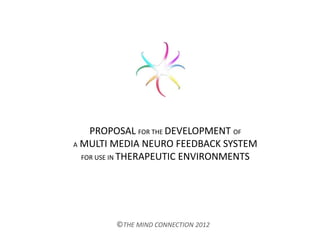
The Mind Connection - concept & possibilities
- 1. PROPOSAL FOR THE DEVELOPMENT OF A MULTI MEDIA NEURO FEEDBACK SYSTEM FOR USE IN THERAPEUTIC ENVIRONMENTS ©THE MIND CONNECTION 2012
- 2. INTRODUCTION NEURO FEEDBACK THERAPY • Based on the registration and feedback of brainwave signals. • Measured with a user friendly wireless 14 channel headset. • Software analyzes the brainwaves and transforms them to sounds and visions. • As an induction the sound and vision feedback influences the senses of the client. • This multi media induction is composed to direct the attention of the client to a desired state. The neuro feedback loop is closed and the client is training his attention to cure his condition.
- 3. HARDWARE connected to The Mind Connection software solutions (avaliable July 2012) Specifications of the Neurosky Mindwave headset Weight: 90g Sensor arm up: height: 225mm x width:155mm x depth: 92mm Sensor Arm down: height: 225mm x width:155mm x depth:165mm Rate power: 30mW (max. 50mW) RF frequency: 2.420 - 2.471GHz RF max. power 6dBm RF data range: 250kbit/s RF range: 10m Packet loss of bytes via wireless: 5% UART Baudrate: 57,600 Baud Max. signal input range: 1mV pk-pk EEG Hardware filter range: 3Hz – 100Hz Resolution: 12 bits ADC Sampling rate: 512Hz eSense calculation rate: 1 Hz
- 4. HARDWARE possible of getting connected to The Mind Connection software solutions Specifications of the Holst Centre Research Project Headset include: • Low-power (1 mW) multi-purpose sensor node • Wireless, low-power ECG patch • Body heat-powered EEG and pulse oximeter system • 2-, 6-, and 25-channel ExG systems • Wearable EMG belt • Wireless emotion monitoring system • BAN for sleep monitoring
- 5. HARDWARE Number of channels 14 (plus CMS/DRL references, P3/P4 locations) Channel names (International 10-20 locations) AF3, F7, F3, FC5, T7, P7, O1, O2, P8, T8, FC6, ,F4, F8, AF4 Sampling method Sequential sampling. Single ADC Sampling rate 128 SPS (2048 Hz internal) Resolution 16 bits (14 bits effective) 1 LSB = 1.95μV Bandwidth 0.2 - 45Hz, digital notch filters at 50Hz and 60Hz Filtering Built in digital 5th order Sinc filter Dynamic range (input referred) 256mVpp Coupling mode AC coupled Connectivity Proprietary wireless, 2.4GHz band Power LiPoly Battery life (typical) 12 hours Specifications of the Emotiv Epoc headset
- 6. PRODUCT DESCRIPTION based on Emotiv Emoc • The base of the software is a network that transforms the input of the brainwave signals of the headset into control signals for a multi channel sound engine and a real-time 3d-graphics engine. • The measured brainwave signals are stored for statistic reproduction • Neuro feedback training protocols can be created trough a separate therapy editor. • The software can be encrypted to avoid software pirating
- 8. SOUND FEEDBACK • A number of selectable sound channels can be linked to the selected training protocol. • State Sound compositions can be created, saved, loaded and played trough the Project menu. For example the Gaia State Sound composition is made to induce a spectrum of nature sounds. • There are 8 stereo sound channels available. Every channel has 4 brainwave controllable sound effects: Filter – Reverb – Flanger – Echo. Screenshot of our actual State Sound application
- 9. SOUND FEEDBACK The Mute buttons can be switched on and off to select one or more sound channels for feedback. • Channel 0 responds to delta waves (campfire sounds) • Channel 1 responds to theta waves (wind sounds) • Channel 2 responds to alfa waves (water sounds) • Channel 3 responds to beta waves (cricket sounds) • Channel 4 responds to the train signal (bird sounds) • Channel 5 responds to the train signal (bell sounds) • Channel 6 produces a slow breathing sound. • Channel 7 produces an instruction voice.
- 10. 3D GRAPHICS Overview of the visual neurofeedback control parameters. Camera : Brainwave controlled multi directional camera animations. Colors : Brainwave controlled red, green and blue mixer. Shapes : Brainwave controlled décor and object animations. Particles : Brainwave controlled particle system animations.
- 11. 3D GRAPHICS • Screenshot of a 3D graphics scene from our actual State Vision application • A number of different scenes will be implemented in the final version of the software
- 12. USER INTERFACE • Screen shot of the 3D graphics menu from our actual State Vision application
- 13. OPTIONS TO IMPLEMENT IN THE USER INTERFACE • Protocol selection • Difficulty level setting • Sensor contact test • Start/Stop + Save/Load brainwave files Example Sensor contact verification on User interface level The Yellow dot indicates a poor signal connection The Red dot indicates a bad signal connection.
- 14. ANALYZE AFTER THERAPY SESSION • Graphs • Tables • Text • Database • Compare with previous sessions • User Data – client based personal data store
- 15. THERAPY DEVELOPER INTERFACE • Dual screen setup possibility • Selectable 3D-scenes • Selectable audio channels • Select what to control in the 3d-scenes and in the audio feedback Example windows from our State Monitor application Creation of a number of protocols
- 16. Creation of control parameters: • Per sensor one or more frequency bands • Per frequency band: min freq, max freq, min level, max level, optimal level, or dynamics (change size + -) • Per sensor artefact detection and repression (muscle tension, eye movements, eye blinks) • Protocol decoding • Protocols for statistics feedback DEVELOPER INTERFACE
- 17. Therapist Patient Online portal Advantages central data storage: • Data analysis • Datamining • Statistics • Direct communication patient <-> therapist • No fixed measure location (measure at home) DB
- 19. THE MIND CONNECTION MULTIMEDIA PLATFORM Processor Bio signal input Audio input Manual input 3D Engine Sound Engine Plugins Video input